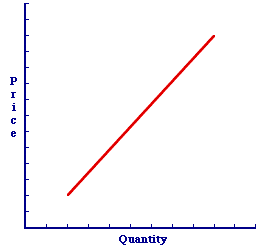
|
|
WEALTH: The net ownership of material possessions and productive resources. In other words, the difference between physical and financial assets that you own and the liabilities that you owe. Wealth includes all of the tangible consumer stuff that you possess, like cars, houses, clothes, jewelry, etc.; any financial assets, like stocks, bonds, bank accounts, that you lay claim to; and your ownership of resources, including labor, capital, and natural resources. Of course, you must deduct any debts you owe.
Visit the GLOSS*arama
|
|


|

|
                           CHANGE IN QUANTITY SUPPLIED: A movement along a given supply curve caused by a change in supply price. The only factor that can cause a change in quantity supplied is price. A related, but distinct, concept is a change in supply. A change in quantity supplied is a change in the specific quantity of a good that sellers are willing and able to sell. This change in quantity supplied is caused by a change in the supply price. It is illustrated by a movement along a given supply curve.In fact, the only way to induce a change in quantity supplied is with a change in the price. Anything else, everything else, causes a change in supply. As the supply price induces a change in the quantity supplied and a movement along the supply curve, the five supply determinants (resource prices, production technology, other prices, sellers' expectations, and number of sellers) remain unchanged. Supply and Quantity SuppliedTo set the stage for an understanding of this difference, take note of two related concepts: - Quantity Supplied: Quantity supply is a specific quantity that sellers are willing and able to sell at a specific supply price. It is but ONE point on a supply curve.
- Supply: Supply is the range of quantities that sellers are willing and able to sell at a range of supply prices. It is ALL points that make up a supply curve.
Making ChangesSo what happens when the phrase "change in" is placed in front of each term?- Change in Quantity Supplied: A change in quantity supplied is a change from one price-quantity pair on an existing supply curve to a new price-quantity pair on the SAME supply curve. In other words, this is a movement along the supply curve. A change in quantity supplied is caused by a change in price.
- Change in Supply: A change in supply is a change in the ENTIRE supply relation. This means changing, moving, and shifting the entire supply curve. The entire set of prices and quantities is changing. In other words, this is a shift of the supply curve. A change in supply is caused by a change in the five supply determinants.
Changing the Quantity| A Change in Quantity Supplied | 
|
A change in quantity supplied is a movement along a given supply curve. A change in supply is a shift of the supply curve. These alternatives can be illustrated with the positively-sloped supply curve presented in this exhibit. This supply curve captures the specific one-to-one, law of supply relation between supply price and quantity supplied. The five supply determinants are assumed to remain constant with the construction of this supply curve.- A Change in Quantity Supplied: A change in quantity supplied, which is only triggered by a change in supply price, is a movement along the supply curve. Click the [A Price Change] button to demonstrate.
- A Change in Supply: A change in supply, which is triggered by a change in any of the five supply determinants, is a shift of the supply curve. Click the [A Determinant Change] button to demonstrate.
An Important DifferenceWhy is this difference so important? The answer is as simple as cause and effect. The supply curve is used (together with demand) to explain and analyze market exchanges. The sequence of events follows a particular pattern.- First, a supply (or demand) determinant changes.
- Second, this determinant change causes the supply curve (or demand curve) to shift.
- Third, the change in supply (or demand) causes either a shortage or a surplus imbalance in the market. The market is in a temporary state of disequilibrium.
- Fourth, the shortage and surplus imbalance causes the price of the good to change.
- Fifth, the change in price causes a change in quantity supplied (and demanded).
- Sixth, the change in quantity supplied (and demanded) eliminates the shortage or surplus and restores market equilibrium.
The key conclusion is that supply (and demand) determinants, which induce changes in supply (and demand), are the source of instability in the market. The change in price, which induces a change in quantity supplied (and demanded) is the means of eliminating the instability and restoring equilibrium.

Recommended Citation:CHANGE IN QUANTITY SUPPLIED, AmosWEB Encyclonomic WEB*pedia, http://www.AmosWEB.com, AmosWEB LLC, 2000-2025. [Accessed: July 1, 2025].
Check Out These Related Terms... | | | |
Or For A Little Background... | | | | | | | | | |
And For Further Study... | | | | | | | | | |
Search Again?
Back to the WEB*pedia
|



|

|
PINK FADFLY
[What's This?]
Today, you are likely to spend a great deal of time calling an endless list of 800 numbers looking to buy either a battery-powered, rechargeable vacuum cleaner or a remote controlled World War I bi-plane. Be on the lookout for mail order catalogs with hidden messages.
Your Complete Scope
This isn't me! What am I?
|

|
|
Cyrus McCormick not only invented the reaper for harvesting grain, he also invented the installment payment for selling his reaper.
|

|
|
"Experience keeps a dear school, but fools will learn in no other. " -- Benjamin Franklin
|

|
ICCH
International Commodities Clearing House
|

|
|
Tell us what you think about AmosWEB. Like what you see? Have suggestions for improvements? Let us know. Click the User Feedback link.
User Feedback
|


|


